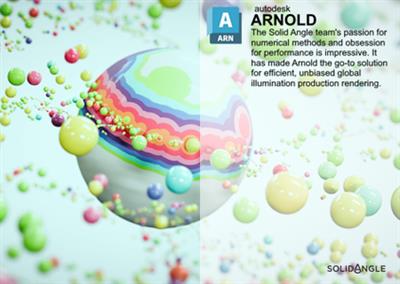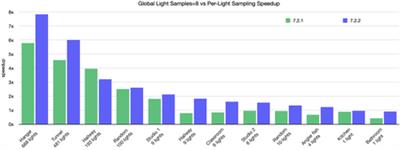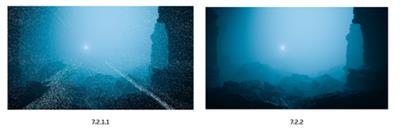Solid Angle Cinema 4D to Arnold 4.6.3 (x64)
- 11.06.2023
- 0

Free Download Solid Angle Cinema 4D to Arnold 4.6.3 | 5.4 Gb
The Team Solid Angle announced the launch of Arnold (C4DtoA) 4.6.3 for Cinema4D. This update uses Arnold 7.2.2.0.
Product:Solid Angle Cinema4D to Arnold
Version:4.6.3
Supported Architectures:x64
Website Home Page :www.arnoldrenderer.com
Languages Supported:english
System Requirements:Windows, macOs & Linux *
Size:5.4 Gb
Enhancements
-Turn off trace sets:You can turn trace sets on and off with a checkbox in the Arnold tag, instead of changing the array size to 0 and losing the set names. (C4DTOA-2970)
-Improved interactivity when modifying large scenes:Arnold 7.2.2 improves the responsiveness of the renderer when modifying large scenes interactively. When editing lights or shaders in scenes with millions of instances, the time to first pixel is nearly instantaneous instead of having to wait multiple seconds. For example, this change improves interactivity greatly when rendering scenes using the point instancer in USD. Modifying nodes during an interactive session now usually results in an update of just the modified node, not of all nodes. In scenes with many nodes, this can substantially speed up interactive node updates. In case of missing updates, you can disable this feature by setting options.enable_fast_ipr to false. An Arnold cache flush can also be used to trigger all nodes to update again. (ARNOLD-4873)
-Improved global light sampling performance:The efficiency of global light sampling with indirect lighting has been improved in many cases. See the global light sampling documentation for more details. (ARNOLD-13381)

-Reduced numerical precision differences across CPU vendors:While images rendered on Intel, AMD, and Apple CPUs were already often perceptually equivalent, we have removed more precision-related differences so that even more results are now perceptually identical. (ARNOLD-5211)
-Reduced noise from mesh lights in volumes:The amount of noise in volumes when using a mesh light with very small triangles is now much reduced. (ARNOLD-11880)

-Specify which AOV to show in kick display:A new kick flag -aov selects the AOV to show in the kick display window. (ARNOLD-13360)
-OCIO color manager handles better missing configs:If the OCIO color_manager is not given a config filename and the OCIO environment variable is not defined, Arnold will now use the builtin config. Previously it would fail with a warning and not apply any color conversions. (ARNOLD-11565)
-Per shape autobump SSS visibility:You can now control whether autobump is visible on SSS for specific shapes, instead of relying on the global control, just as you can for the other autobump visibility controls. This setting has subtle effects and can increase rendering times, so enabling it only where it matters will help optimize scenes. (ARNOLD-12989)
-Update CER:The Customer Error Reporting (CER) library is updated to v6.2.3. (ARNOLD-13510)
USD Enhancements
-Load 3rd party MaterialX node definitions:It is now possible to render MaterialX nodes defined in third-party node definitions using the ARNOLD_MATERIALX_NODE_DEFINITIONS environment variable. (ARNOLD-13398)
-Estimated render time in the Render Delegate:Add Arnold render status and estimated render time to viewport annotation. usd#1492 -
-Camera filters:Add support for camera filtermap and uv_remap. usd#1499
-Deterministic USD prototype names:This change forces USD to generate non-random prototype names for instances when using the USD_ASSIGN_PROTOTYPES_DETERMINISTICALLY environment variable. This addresses frame stability issues when using Cryptomatte. (ARNOLD-13349)
-Material scope:Add a Mtl scope for materials when authoring usd file. usd#1486
-Subsurface ray visibility:Add AI_RAY_SUBSURFACE visibility flag support in the render delegate and procedural. usd#1529
API Additions
-AiMallocUsableSize():AiMallocUsableSize() returns how much memory a pointer returned by AiMalloc() is using. This is helpful when paired with AiAddMemUsage() for tracking memory allocation and deallocations. (ARNOLD-13354)
-Per-object subsurface autobump visibility:The per-object autobump_visibility flag AI_RAY_SUBSURFACE now toggles the appearance of autobump normal perturbations in subsurface scattering effects. (ARNOLD-12989)
-Support ARNOLD_MATERIALX_NODE_DEFINITIONS in AiMaterialxGetOslShaderCode:The AiMaterialxGetOslShaderCode function will now respect the value of the ARNOLD_MATERIALX_NODE_DEFINITIONS environment variable, and also supports an optional MATERIALX_SEARCH_PATH argument to load 3rd part MaterialX node definitions. (ARNOLD-13398)
-Forcing node updates:To force a specific AtNode type to be always updated, you can set the boolean metadata force_update to true on the node : AiMetaDataSetBool(node_entry, nullptr, "force_update", true); (ARNOLD-4873)
Incompatible changes
-Deprecated sss_use_autobump:The sss_use_autobump global option is now deprecated in favor of the per-object autobump_visibility flag. While the global option still works, it now prints a warning when used, and will eventually be removed. (ARNOLD-12989)
Bug Fixes
- C4DTOA-2976 - Save Project with Assets does not save textures from Asset Brower
- C4DTOA-2977 - Crash in Cinema 4D 2023 when setting LUT file in tonemap imager
- C4DTOA-2978 - IPR crash when removing normal channel of a C4D Standard Material
- C4DTOA-2979 - Trace sets of the Arnold Thinking Particle object are not exported
- C4DTOA-2982 - IPR does not update correctly when switching cameras
- C4DTOA-2983 - First instance of the Arnold Scatter object does not distribute randomly
- C4DTOA-2984 - First value of a random sequence does not distribute randomly
- C4DTOA-2987 - Render to Picture Viewer randomly hangs in Cinema 4D 2023.2 on Apple Silicon
- C4DTOA-2997 - Random crash on macOS when closing Cinema 4D
- C4DTOA-2998 - Can not link operator nodes via the input menu
- C4DTOA-2999 - Crash when replacing a node in the legacy node editor
- C4DTOA-3000 - Source geometry is visible when instancing X-Particles group
- ARNOLD-11789 - AiAOVSampleIteratorGetInvDensity for non-adaptive renders was always 1
- ARNOLD-11880 - Bright pixel artifacts in atmosphere_volume when using a mesh light with very small triangles
- ARNOLD-11888 - OIDN doesn't work if noice denoising AOVs are also output
- ARNOLD-11900 - AOV samples memory stats report negative value and large unaccounted memory
- ARNOLD-12774 - Support multipart scanline EXRs
- ARNOLD-13346 - Set_transform in append mode only considers the first matrix key
- ARNOLD-13376 - Crash when modifying a mesh referenced by an instancer node
- ARNOLD-13460 - Strip _forced_box_filter from .ass export
- ARNOLD-13463 - UDIM tiles greater than 1009 do not render with MaterialX image nodes
- ARNOLD-13495 - Hang when reading corrupt .ass file
- ARNOLD-13511 - RLM_DEBUG env var prints weird characters
- ARNOLD-13512 - Incorrect values in Arnold MaterialX Node Definitions
- ARNOLD-13523 - Fix slowdown when using big arrays of nodes with the dependency graph enabled
- ARNOLD-13539 - Log messages from AiScene API incorrectly reference "[ass]" when .ass file are not used
- ARNOLD-13550 - Quad light sometimes produces NaN artifacts
- ARNOLD-13615 - AutoTX occasionally uses wrong colorspace
- usd#1502 - Render delegate crashes with empty arrays
- usd#1522 - Support UsdPrimvarReader_float2 shader returning the st variable
- usd#1530 - Fix a crash when a user primvars has an empty array on a keyframe
Arnoldis an advanced cross-platform rendering library, or API, developed by Solid Angle and used by a number of prominent organizations in film, television and animation, including Sony Pictures Imageworks. It was developed as a photo-realistic, physically-based ray tracing alternative to traditional scanline based rendering software for CG animation. Arnold uses cutting-edge algorithms that make the most effective use of your computer's hardware resources: memory, disk space, multiple processor cores, and SIMD/SSE units. The Arnold architecture was designed to easily adapt to existing pipelines. It is built on top of a pluggable node system; users can extend and customize the system by writing new shaders, cameras, filters and output driver nodes, as well as procedural geometry, custom ray types and user-defined geometric data. The primary goal of the Arnold architecture is to provide a complete solution as a primary renderer for animation and visual effects.
Arnold for Cinema4D (C4DtoA)supports most Cinema 4D features such as instances, cloners, deformers, generators, MoGraph geometry, hair, and ThinkingParticles. It also supports both animation and single frame distributed rendering in Team Render, allowing the use of all computers in a local network to speed-up Arnold rendering. Third-party plugins TurbulenceFD and X-Particles are natively supported, allowing artists to render high quality smoke, fire, and particle effects with fully interactive feedback. Other features include volume rendering with OpenVDB, a node-based material editor and a comprehensive list of shaders and utilities, including vertex maps and per-face materials.
The Ultimate Introduction to Arnold 6 (& 7) For Cinema 4d
Solid Angle SLis the technology company behind the Arnold rendering software, with offices in Madrid and London and customers throughout the world including Framestore, DreamWorks, ILM, Sony Pictures Imageworks, MPC, The Mill, Mikros Image and Rising Sun Pictures. Arnold was designed from the ground up to efficiently raytrace the complex geometric datasets required for feature-length CGI animation and big budget visual effects, while at the same time simplifying the pipeline, reducing the number of passes, minimizing storage requirements and greatly enhancing interactivity for lighting artists.
Download
Rapidgator-->Click Link PeepLink Below Here Contains Rapidgator
http://peeplink.in/0caadbc2a182
Uploadgig
0itq6.setup.part1.rar
0itq6.setup.part2.rar
0itq6.setup.part3.rar
NitroFlare
0itq6.setup.part1.rar
0itq6.setup.part2.rar
0itq6.setup.part3.rar
Links are Interchangeable - Single Extraction